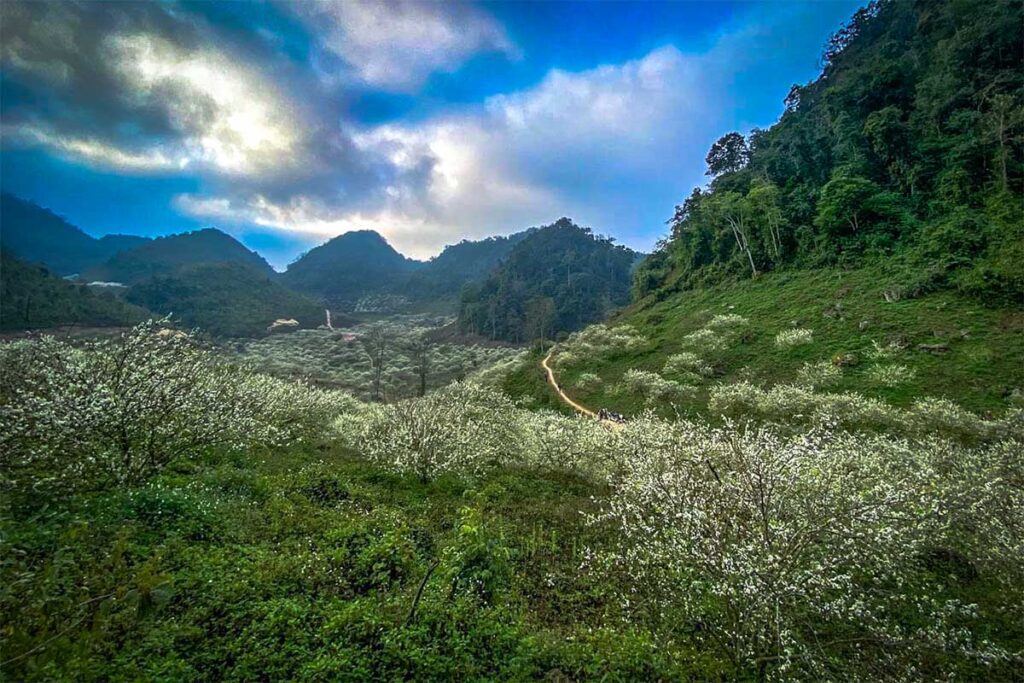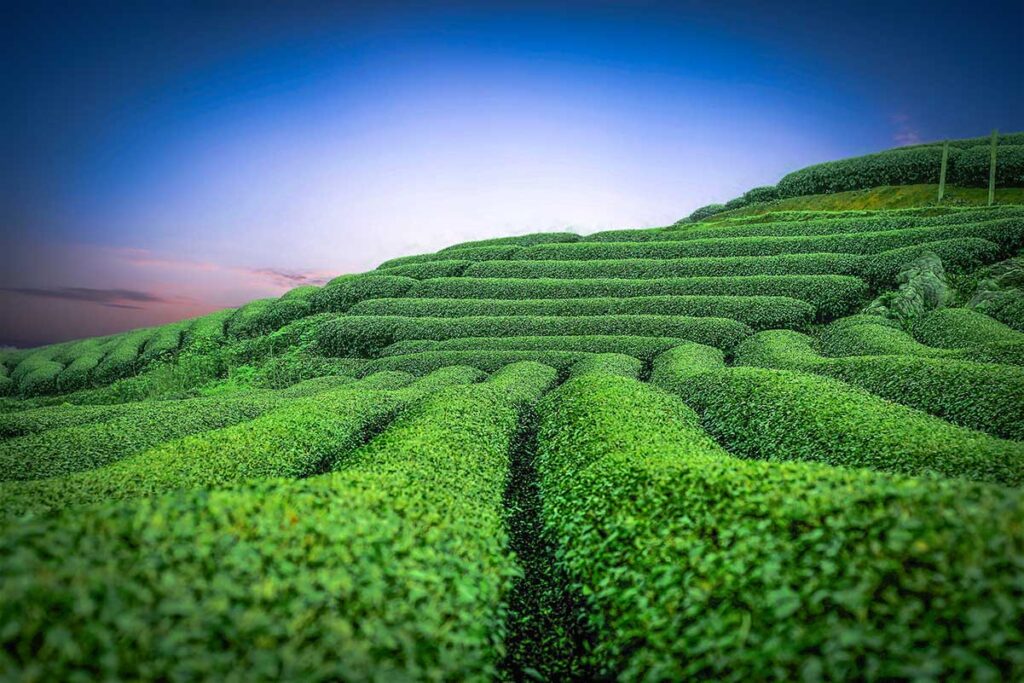What is Na Ka Plum Valley like?
Na Ka Plum Valley is a wide, scenic valley located about 16 kilometers from Moc Chau town, surrounded by rolling hills and fruit orchards. It’s best known for two distinct seasons: white plum blossoms that blanket the valley from January to February, and the plum harvest from April to May, when visitors can walk through the gardens and pick fruit directly from the trees.
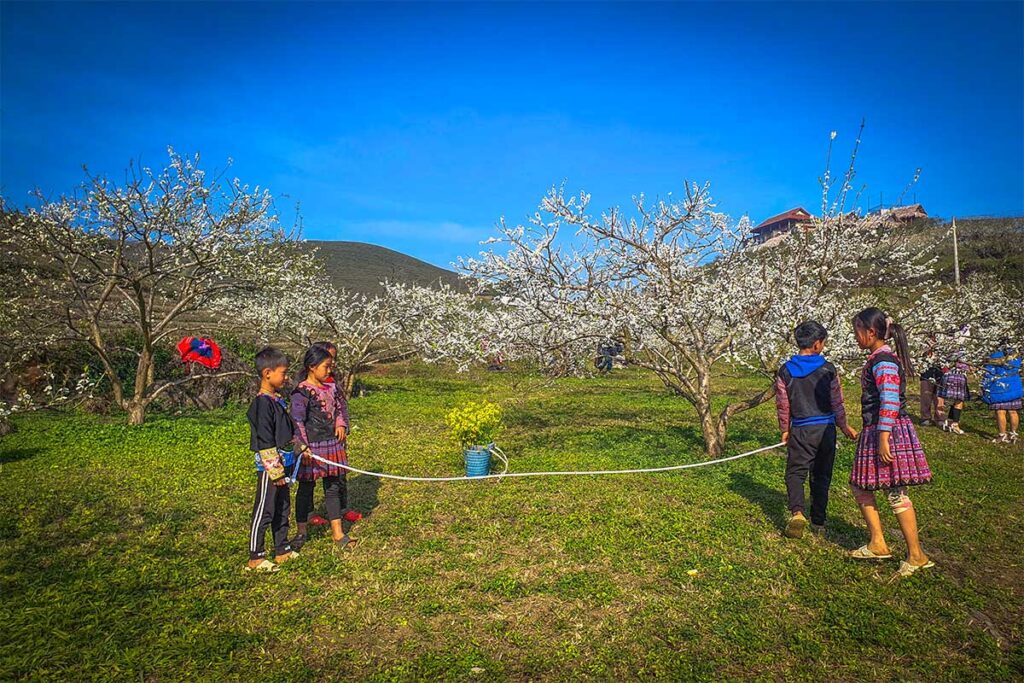
While the area feels peaceful on quiet days, it can get crowded during weekends and holidays, especially around Tet — and although it’s the most famous plum blossom spot in Moc Chau, it’s not the only one in the region worth exploring.
Best time to visit Na Ka Plum Valley
Plum blossom season (Mid‑January to February)
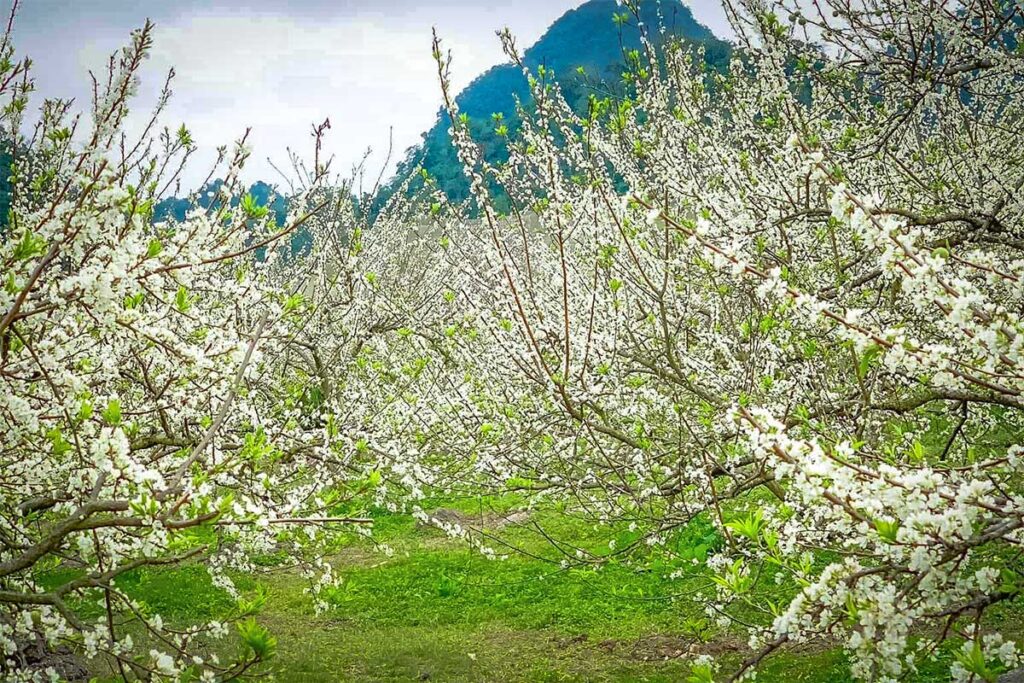

This is the valley’s peak: plum trees burst into white blooms for about 10–15 days. It’s an ideal time for stunning photos — aim for late morning to early afternoon when fog has lifted and light is best. However, this period often overlaps with Tet (Lunar New Year), so expect bigger crowds and higher prices.
Harvest season (April–May)
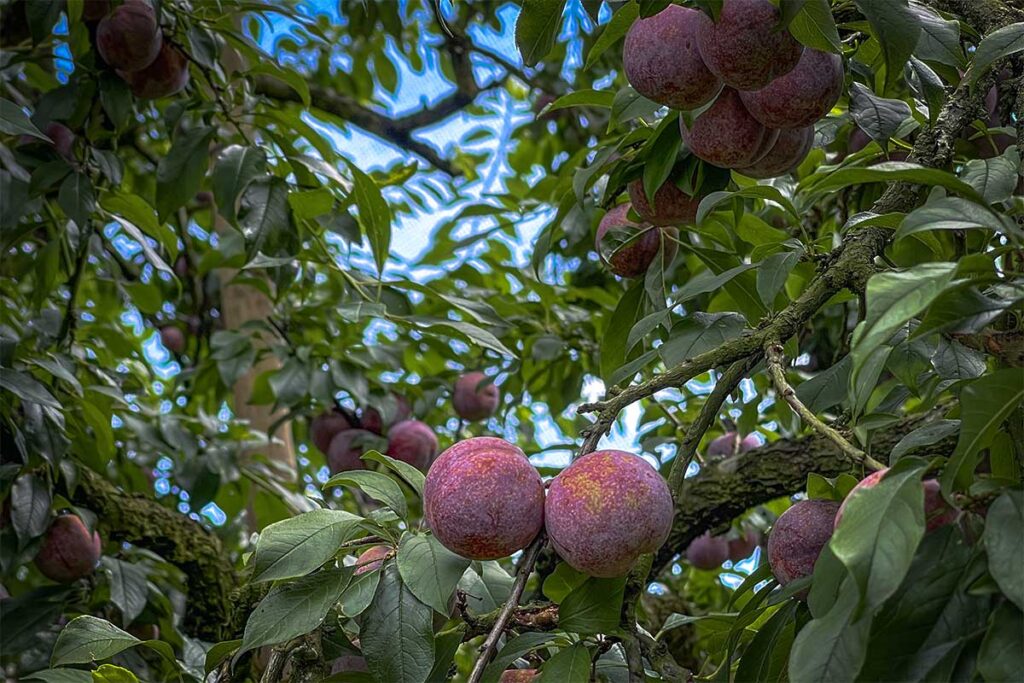
Spring turns into summer, and the valley becomes a paradise for fresh plum picking and tasting. The trees are laden with ripe, juicy fruit — a fun and tactile experience, especially for families. It’s less crowded than peak bloom, but still a festive, active time.
Off‑Season (June–December)
From June through December, the valley is empty of flowers or fruit. The landscape still has its charm, but most orchards won’t be in bloom or offering picking, and entrance fees during off‑season aren’t worth it unless you’re just passing through.
Things to do in Na Ka Plum Valley
Na Ka isn’t a large attraction with fixed highlights — it’s more about the seasonal experience. What you’ll do here depends entirely on when you visit. From walking through white blossom orchards to picking ripe plums or just enjoying the mountain scenery, here’s what to expect.
1. Walk among plum blossoms (In season)
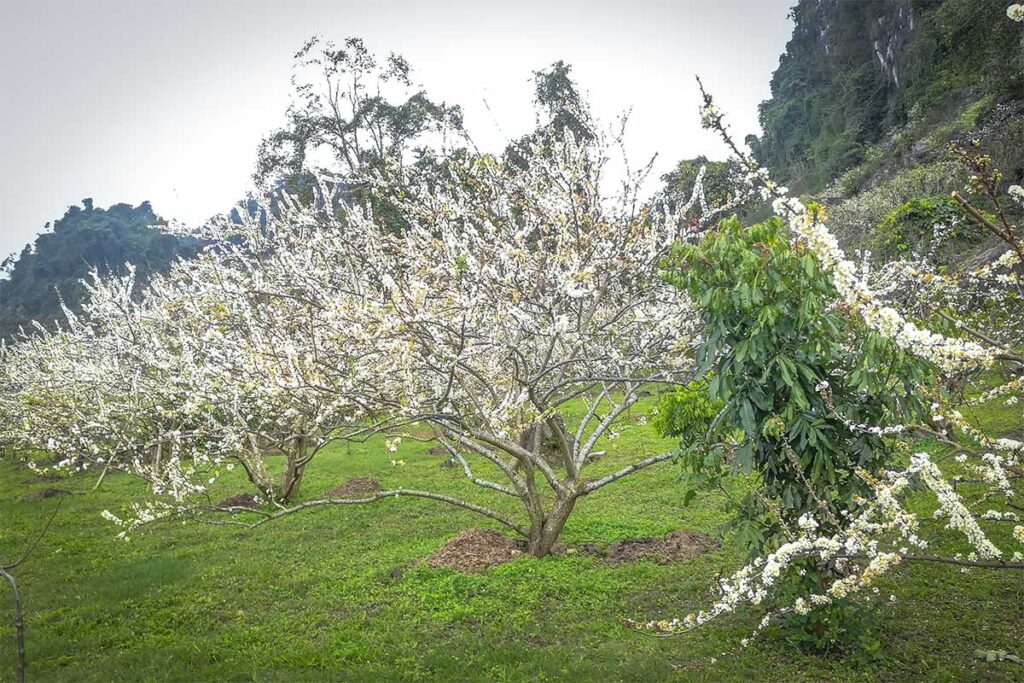
If you visit during the short blossom season (usually January to February), the main activity is simply walking among the trees and taking in the scenery. Most orchards are privately owned, so you’ll need to pay a small entrance fee — usually around 20,000–30,000 VND per person.
Each orchard is slightly different. Some have short trails, bamboo viewing platforms, or photo props like swings and wooden carts. The layout isn’t complicated, and you can easily visit a couple of orchards in a single stop. Just be aware that some owners may try to overcharge, especially if you’re a foreigner — if the price feels unreasonable, politely move on to the next one.
2. Pick and Taste Plums (Harvest Season)
During the harvest season (April to May), you can walk through the same orchards and pick ripe plums straight from the tree. Most places let you taste a few as part of the entrance fee. If you want to take some home, you can buy them by the kilo — prices vary, but expect around 20,000–30,000 VND/kg, sometimes more for the best fruit.
The plums in Na Ka are known for being crunchy, sweet-sour, and fresh, especially when eaten on the spot. Some orchards also sell plum-based products like jam, syrup, or local plum wine. It’s a nice souvenir if you’re into local food.
3. Photo Spots and Traditional Costumes
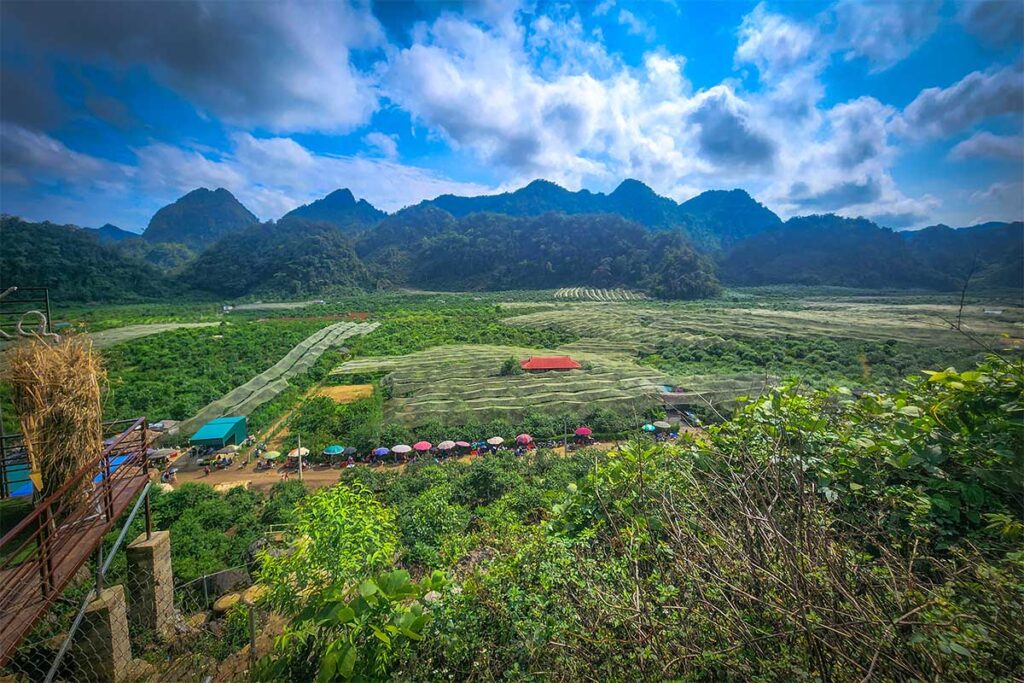
A big part of the Na Ka experience — especially during blossom season — is the photo-taking. You’ll see plenty of staged photo spots throughout the valley, often set up by local orchard owners to attract visitors. These include swings, bamboo huts, wooden carts, and small viewpoints, sometimes arranged in slightly over-the-top ways.
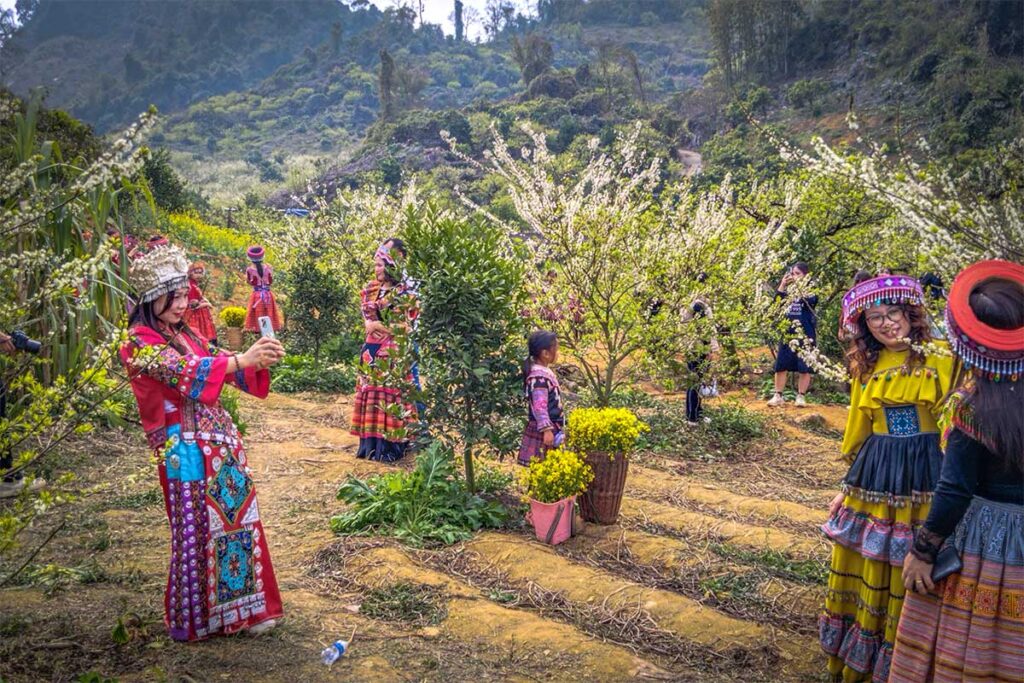
While these setups are clearly designed with domestic tourism in mind, they can still be fun if you’re in the mood for it. Some travelers enjoy the creative backdrops, while others find them a bit too commercial. Either way, it’s all part of the atmosphere — and you can easily skip them if you prefer more natural shots.
There are also traditional ethnic costumes for rent, usually Hmong, Thai, or Dao. It’s common to see groups dressed up for family or couple photos, especially on weekends. While this may feel touristy, it’s very popular among Vietnamese visitors. If you’re interested, the rentals are inexpensive and make for colorful photos — but it’s just as valid to enjoy the scenery without the props.
4. Drive around the valley
Even if you don’t stop in every orchard, just driving through the valley is part of the experience. The road winds between low hills and farms, with mountain views on the horizon and plum trees lining both sides. The scenery is especially beautiful when the valley is in bloom or full of fruit.
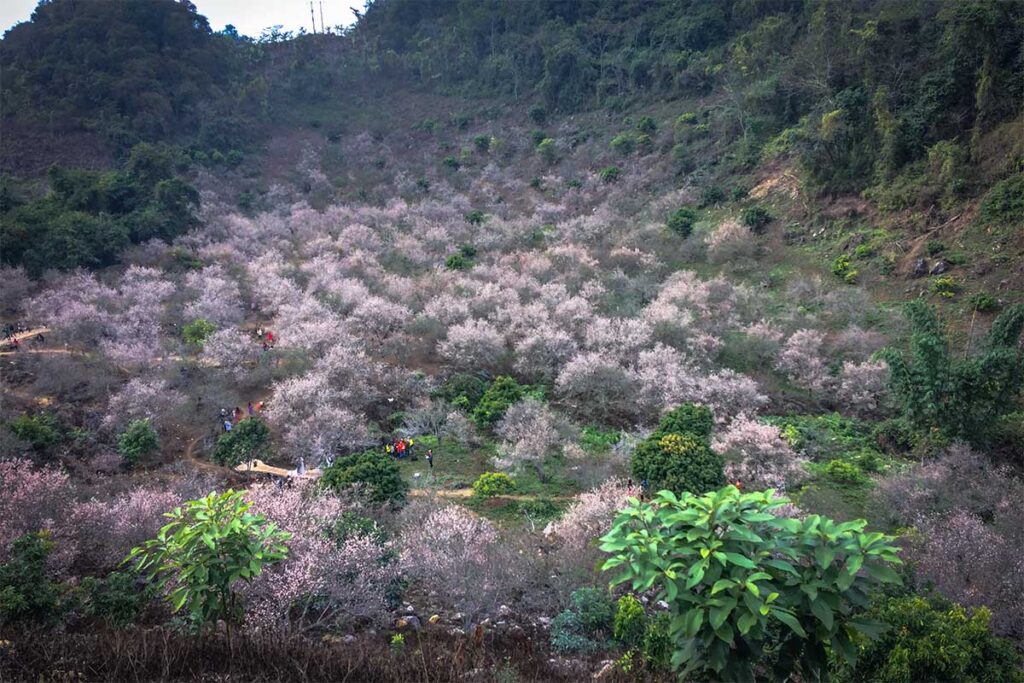
The road into the valley is narrow and steep in parts, so if you’re not confident riding a motorbike, it’s better to hire a local motorbike taxi or go with a driver who knows the area. On quiet weekdays, it’s a peaceful ride. On weekends, expect a bit more traffic and people waving you into their farms.
How to get to Na Ka Plum Valley
The first step is getting to Moc Chau, which is fairly straightforward. There are daily buses and limousine vans from Hanoi, making it an easy trip for independent travelers. You can check all the travel options here: How to get from Hanoi to Moc Chau.
Once you’re in town, it’s a short but scenic journey into the hills.
From Moc Chau Town
Na Ka Plum Valley is located about 16 kilometers from the center of Moc Chau.
From town, follow Provincial Road 104, then turn onto a narrow side road that winds its way into the valley. You’ll pass tea fields, farms, and patches of forest — it’s a pretty drive.
You can go by motorbike (rented in town) or take a motorbike taxi (xe ôm). The road is paved, but the last part involves a steep climb into the valley, so it’s important to be confident if you’re riding yourself.
If you prefer more comfort, you can also get there by car or taxi. Taxis are fine for a short visit, but make sure the driver waits — mobile signal in the valley can be spotty. A better option is to rent a car with driver for the day, which gives you more flexibility to also stop at places like the tea hills or Tat Nang Waterfall afterward. Prices are usually fixed by itinerary.
Book a private car to visit Na Ka
Getting to Na Ka is easier with your own driver — and you can combine it with sightseeing around Moc Chau’s valleys, waterfalls, and tea hills.
Road conditions
The final section of the road has some steep slopes (up to 8% incline) and a few tight curves. It’s fine in dry weather, but can get slippery when it’s wet or foggy — which is common in the mornings during blossom season.
If you’re not experienced on a motorbike, it’s safer to go with a local driver. A motorbike taxi from town typically costs around 120,000 VND each way. Some orchard owners also offer transport up and down the hill if you’re visiting their gardens.
Entrance fees & costs
Na Ka Plum Valley doesn’t have a single unified ticket — instead, each orchard sets its own entrance fee, usually around 20,000–30,000 VND per person. Most charge the same price for both blossom season and harvest time.
Some orchard owners may try to overcharge foreign tourists, especially during busy times. If the price feels unreasonable, it’s best to politely decline and walk to the next orchard — there are plenty to choose from, and the difference in scenery is usually minimal.
Parking fees are also charged separately in most areas. Expect to pay 5,000–10,000 VND for a motorbike and no more than 20,000 VND for a car. If someone asks for more, you’re likely being taken advantage of.
During peak blossom season, entrance prices don’t officially change, but some places do push limits, and crowds make it harder to negotiate. Weekdays are more relaxed and often cheaper.
There are also optional extra costs:
- Buying plums by the kilo (if visiting in harvest season)
- Renting costumes for photos
- Local snacks like grilled corn or sticky rice
- Small souvenirs or plum-based products
- Paid photo props or setups in some orchards
Most of these are low-cost and easy to skip if you’re not interested.
What to expect
Na Ka Plum Valley is beautiful when in season, but it’s not a polished tourist attraction. Here’s what to know before you go.
Crowds and atmosphere
During Tet and blossom weekends, the valley can be packed — expect traffic jams on the access road, lots of parked vehicles, and busy orchards. For a quieter experience, visit on a weekday or come during the early harvest season, when things are more relaxed.
On the way in, some orchard owners may wave you down or approach you to invite you into their farm. It’s normal — they’re just trying to attract visitors — but you’re free to continue to another spot if you prefer.
Food and facilities
Food in the valley is very limited. You’ll find a few stalls selling grilled corn, sweet potatoes, boiled eggs, or sticky rice, but don’t expect full meals. It’s best to eat before or after your visit in Moc Chau town, where there are proper restaurants.
Some orchards offer basic toilet facilities, but others don’t have any — so plan accordingly, especially if you’re visiting with kids.
Weather & Clothing
Fog is common early in the morning, especially during blossom season. It usually clears around 9am, which is also when light becomes ideal for photos.
The ground can be muddy or uneven, especially after rain, so wear good walking shoes or rubber boots. In blossom season (January–February), bring warm layers. During harvest, it’s usually sunny and warm, so hat and sunscreen are useful.
Photo etiquette
It’s tempting to get the perfect shot, but be mindful not to break branches, step on plants, or pick unripe fruit — these are working farms, not photo studios.
If you want to take photos of ethnic minority children or people working in the orchards, it’s polite to ask first or gesture clearly. Most will smile or nod, but don’t assume it’s always okay.
Is Na Ka Plum Valley worth visiting?
If you visit during blossom season or harvest time, Na Ka Plum Valley is one of the highlights of Moc Chau. The scenery is beautiful, the atmosphere can be lively or peaceful depending on when you go, and the experience — whether walking among white blossoms or picking fresh plums — feels authentic when timed right.
Outside these short seasonal windows, however, the valley loses much of its appeal. With no flowers or fruit, and limited facilities, it’s probably not worth the trip or entrance fees unless you’re already passing by.
If you’re looking for a quieter alternative during blossom season, consider Mu Nau Valley. It has similar landscapes, fewer crowds, and a more peaceful feel, though fewer tourist services.
For photographers, families, and nature lovers, Na Ka is a great stop — but only if you catch it at the right time.
What is nearby?
Na Ka is just one part of the larger Moc Chau Plateau, a highland region known for its fresh air, tea fields, and seasonal flower valleys.
One of the most iconic sights in Moc Chau is the vast tea plantations5 Best Tea Plantations on Moc Chau Plateau, especially around Heart Tea Hill and Shan Tuyet farms, where you can walk or ride through rows of green terraces. They’re most photogenic in the early morning or late afternoon.
If you’re looking for nature spots, nearby waterfalls like Dai Yem Waterfall or the smaller Chieng Khoa Waterfall are popular for a refreshing break, especially in the warmer months.
And in recent years, one of the biggest attractions in the area has become the Bach Long Glass Bridge — officially the longest glass-bottom bridge in the world — offering sweeping views and a bit of thrill.
For a full overview of what to do around the area, check out our complete guide: Best things to do in Moc Chau
